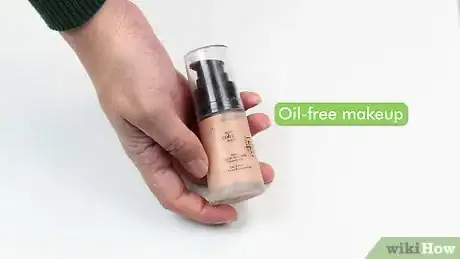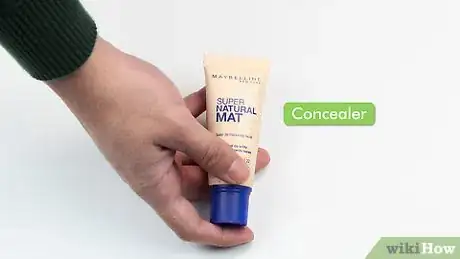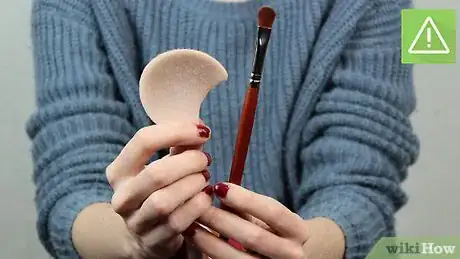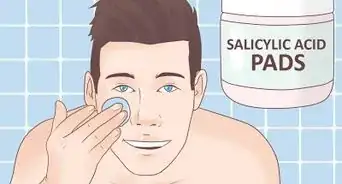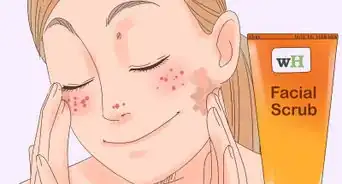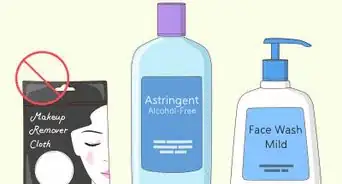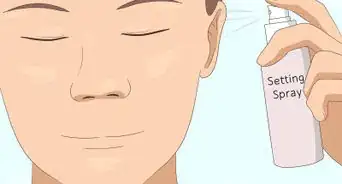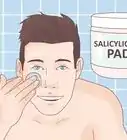This article was co-authored by Tymia Yvette. Tymia Yvette is a Makeup and Lash Artist and the founder of Tymia Yvette Beauty LLC, a makeup artistry and lash extension company focused on customized beauty services based in Baltimore, Maryland. Trained by MAC Cosmetics, Tymia's work has been featured in the Bravo A-List Awards 2008, the BET Honors Award Show in 2011, 2012, and 2013, the Mercedes-Benz New York Fashion Week 2011, 2012, and 2013, and the White House Correspondent's Dinner in 2014. She has also provided makeup and lash services for the Betsy Royal Casting Agency and the Baltimore Raven's cheerleading squad from 2010 to 2012. Her clients include Terrence Howard, Torrey Smith, Lester Holt, Adrienne Lofton, and Natasha Hastings. She has been awarded WeddingWire's Couple's Choice Award in 2017, 2018, and 2019.
There are 7 references cited in this article, which can be found at the bottom of the page.
wikiHow marks an article as reader-approved once it receives enough positive feedback. In this case, 88% of readers who voted found the article helpful, earning it our reader-approved status.
This article has been viewed 569,322 times.
Makeup comes in handy when you're trying to hide a breakout. Rather than layering on more than you'd normally wear, combine spot-treatment with a thin layer of foundation. Makeup doesn't have to be hard on your skin: with good hygiene and oil-free products, you can hide your acne without clogging your pores.
Steps
Finding the Right Makeup
-
1Acquire oil-free makeup. Cosmetics that do not clog pores are called noncomedogenic or non-acnegenic. The first ingredient in your makeup should be water. [1] . Opt for mineral-based cosmetics, which will absorb excess oil and hide redness without irritating your skin.
- Noncomedogenic makeup does not interfere with acne medication.[2]
-
2Pick the right primer for your skin. Use oil-free primer to keep your makeup in place. It can be especially difficult to keep concealer on an inflamed zit, but a dab of primer does the trick. Lightweight primers are less likely to irritate acne and are easier on oily skin.
- Use a primer with SPF for protection from the sun, especially if you have scarring or hyperpigmentation. Sun exposure can slow the healing process.
- Apply the primer all over your face to help your makeup go on evenly and last longer.
Advertisement -
3Consider a powder foundation. A mineral-powder foundation is less likely to clog your pores than a liquid foundation, though it will provide less coverage. Opt for mattifying products: they absorb excess oil, and a matte finish conceals bumpiness.
- Avoid shimmery finish, which will draw attention to bumps.
- Foundations that are designed to last all day are more likely to clog your pores, causing further acne.
- If you're interested in light coverage, an oil-free tinted moisturizer can work great on acne-prone skin. It also won't clog pores!
-
4Find or make a concealer that matches your skin tone. Concealer that is too light or dark will highlight your trouble spots, rather than hiding them. Mix two shades of concealer if you cannot find one that matches your skin. [3]
- Keep in mind that oily skin can oxidize the concealer, which will make it look darker. You can avoid this by choosing a concealer that is 1/2 a shade lighter than your skin color.
-
5Consider using a setting powder. Setting powder can benefit oily skin, but can exacerbate dryness in other skin. If you choose to use it, find a light setting powder that is less likely to trap oils under your skin.
Applying the Makeup
-
1Clean and moisturize your skin. Before applying makeup, gently wash your face with warm water. Gently rub in a fragrance-free water-based moisturizer. Apply a sunscreen or a moisturizer-sunscreen combination for protection against the sun.
-
2Sanitize your brush or sponge. You can use brushes or sponges to apply your makeup if you would like to avoid touching your skin. Acne can be caused by bacteria on the hands, but sponges or brushes can also hold bacteria, so be sure wash them at least twice a week.
- Keep your work area clean to avoid spreading bacteria when you put on your makeup. Wash your face and hands before you start, disinfect the surface where you'll be working, and sanitize any brushes and tools you plan to use.[6]
- Be sure to cleanse your brushes after you finish your makeup application, as well.[7]
-
3Apply primer. Wait a few minutes to allow your skin to absorb the moisturizer, then use your fingers or a sponge to apply primer. If you prefer not to use a primer across your whole face, you can dab it onto problem spots to help fasten your concealer.
-
4Apply concealer. Wait a few minutes for your primer to set, then apply concealer in an x to your acne. Gently pat it in place. Do not rub, or it may streak.
- You may prefer to wait on the concealer after you have applied foundation, as foundation will cover many of the milder occurrences of acne.
- You can use a green concealer to diffuse pigmentation. Never apply green concealer after applying foundation. Alternatively, you could apply a yellow concealer for a more subtle color correction.
EXPERT TIPLaura Martin is a Licensed Cosmetologist in Georgia. She has been a hair stylist since 2007 and a cosmetology teacher since 2013.Licensed Cosmetologist
 Laura Martin
Laura Martin
Licensed CosmetologistChoose a green or flesh-toned concealer for red blemishes. Laura Martin, a cosmetologist, says, “You can use a green concealer to cover pimples that are red or inflamed, or you can use a flesh-colored one. If you choose the second option, select one that is about half a shade lighter than your natural skin tone.”
-
5Apply foundation. Wait a few seconds for your concealer to set, then use a brush to apply foundation. Use as little as possible. If your first application seems inadequate, add light, even layers until you are satisfied with the result.
- If you still have spots, wait a few minutes for your foundation to set, then add concealer.
- If you are finishing with a setting powder, you can apply it now. With a brush, apply it on your skin in slow circles.
- Once your foundation has set, you can apply the rest of your makeup.
-
6Finished.
Expert Q&A
-
QuestionHow does a stippling brush work?
 Laura MartinLaura Martin is a Licensed Cosmetologist in Georgia. She has been a hair stylist since 2007 and a cosmetology teacher since 2013.
Laura MartinLaura Martin is a Licensed Cosmetologist in Georgia. She has been a hair stylist since 2007 and a cosmetology teacher since 2013.
Licensed Cosmetologist A stippling brush allows you to apply concealer or foundation in concentrated areas. It is great for concealing blemishes.
A stippling brush allows you to apply concealer or foundation in concentrated areas. It is great for concealing blemishes. -
QuestionHow do you cover up a hickey?
 Laura MartinLaura Martin is a Licensed Cosmetologist in Georgia. She has been a hair stylist since 2007 and a cosmetology teacher since 2013.
Laura MartinLaura Martin is a Licensed Cosmetologist in Georgia. She has been a hair stylist since 2007 and a cosmetology teacher since 2013.
Licensed Cosmetologist You can dab concealer on it and blend in. Try using a warm peach or salmon color to counteract the bluish tones.
You can dab concealer on it and blend in. Try using a warm peach or salmon color to counteract the bluish tones. -
QuestionHow do I hide blemishes?
 Laura MartinLaura Martin is a Licensed Cosmetologist in Georgia. She has been a hair stylist since 2007 and a cosmetology teacher since 2013.
Laura MartinLaura Martin is a Licensed Cosmetologist in Georgia. She has been a hair stylist since 2007 and a cosmetology teacher since 2013.
Licensed Cosmetologist Dot concealer on top of them using a stippling motion. Don't dry to blend or smudge.
Dot concealer on top of them using a stippling motion. Don't dry to blend or smudge.
Warnings
- If your skin swells or becomes itchy or red after you apply makeup, stop using it. Some cosmetics include allergenic ingredients that can cause contact dermatitis. [9]⧼thumbs_response⧽
- To help prevent skin irritation, check the expiration date on your makeup and be sure to throw out any product that's expired.[10]⧼thumbs_response⧽
References
- ↑ http://www.webmd.com/skin-problems-and-treatments/acne/make-up?page=2#2
- ↑ http://www.mayoclinic.org/diseases-conditions/acne/basics/causes/con-20020580
- ↑ http://www.webmd.com/skin-problems-and-treatments/acne/ss/slideshow-acne-cover-ups
- ↑ http://www.webmd.com/skin-problems-and-treatments/acne/make-up?page=3
- ↑ Tymia Yvette. Makeup & Lash Artist. Expert Interview. 22 April 2020.
- ↑ Tymia Yvette. Makeup & Lash Artist. Expert Interview. 22 April 2020.
- ↑ Tymia Yvette. Makeup & Lash Artist. Expert Interview. 22 April 2020.
- ↑ http://www.webmd.com/skin-problems-and-treatments/acne/make-up?page=2#2
- ↑
- ↑ Tymia Yvette. Makeup & Lash Artist. Expert Interview. 22 April 2020.
- http://www.webmd.com/skin-problems-and-treatments/acne/make-up?page=2#2
About This Article
If you want to hide your acne with makeup, start with clean, moisturized skin, then apply primer to your blemishes help your concealer stay in place. Wait a few minutes for the primer to set, then apply concealer to your acne and gently pat it until it’s blended. You may want to use a green or yellow concealer to offset any redness. Use a brush to apply a light layer of foundation to your face, then apply the rest of your makeup as usual. To learn more from our Cosmetologist co-author, like how to use a setting powder to hide acne, keep reading the article!
